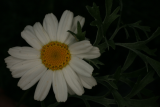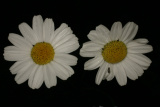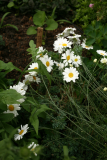Additional notes (click to expand)
Medicinal
Traditional Herbal Medicine Registration (THMR).
Tanacetum cinerariifolium Sch.Blp. Asteraceae Dalmatian chrysanthemum, Pyrethrum, Pellitory, Tansy. Distribution: Balkans. Source of the insecticides called pyrethrins. The Physicians of Myddfai in the 13th century used it for toothache. Gerard called it Pyrethrum officinare, Pellitorie of Spain but mentions no insecticidal use, mostly for 'palsies', agues, epilepsy, headaches, to induce salivation, and applied to the skin, to induce sweating. He advised surgeons to use it to make a cream against the Morbum Neopolitanum [syphilis]. However he also describes Tanacetum or Tansy quite separately.. Quincy (1718) gave the same uses; Woodville (1792) only recommends it for intestinal worms, Bentley (1861) used it as a tonic and for intestinal worms, Flucker & Hanbury (1879) used it to induce salivation. Martindale (1936) had all the insecticidal uses from scabies to mosquito repellent and as a treatment for intestinal worms. Whatever the confusion regarding names, it is hard to see that it was used as an insecticide until a hundred years ago.
Oakeley, Dr. Henry F. (2013) Wellcome Library notes.
Nomenclature
Syn. = Chrysanthemum cinerariaefolium; Syn. = Pyrethrum cinerariifolium
Other use
The dried flower heads of Tanacetum coccineum and T. cinerariifolium are the source of the commercially available insecticide pyrethrum which is non-toxic to mammals and the most commonly used non-synthetic insecticide. It is certified in organic agriculture. Tanacetum coccineum contains insecticidal pyrethrum, but it is a poor source compared to T. cinerariifolium.
Tanacetum coccineum and T. cinerariifolium are used as companion plants to repel pest insects from crops and ornamental plants. Affected pests include: aphids, leafhoppers, spider mites, cabbage white and bed bugs (Cimex lectularius).
Pyrethroids are synthetic insecticides based on natural pyrethrum (pyrethrins); one common example is permethrin. A common formulation of pyrethrin is in preparations containing the synthetic chemical piperonyl butoxide: this has the effect of enhancing the toxicity to insects and speeding the effects when compared with pyrethrins used alone. These formulations are known as synergized pyrethrins.
Toxicity
Allergies to pyrethrum and flowers.
Professor Anthony Dayan, 2021
Pyrethrum should be handled with caution. People exposed to concentrated amounts of pyrethrum (in the eyes, on the skin or ingesting) may experience symptoms including pruritus, dermatitis, papules, erythema, rhinorrhea and asthma.
Geographical distribution
- Europe, Southeastern Europe, Albania
- Europe, Southeastern Europe, Yugoslavia
Podcast
Tanacetum cinerariifolium (Treuir.)Schutz-Bip.
Family: ASTERACEAEGenus: Tanacetum
Species: cinerariifolium (Treuir.)Schutz-Bip.
Common names: Dalmatian chrysanthemum; Pyrethrum; Pellitory; Tansy
Pharmacopoeia Londinensis name: Pyrethrum
Distribution summary: Europe
Habit: Short-lived Perennial
Hardiness: H5 - Hardy; cold winter
Habitat: Grassy sites: meadows, pastures, roadsides
Garden status: Currently grown
Garden location: Olive tree bed (O)
Flowering months: July, August
Reason for growing: Medicinal, other use

.JPG)





.JPG)


.JPG)